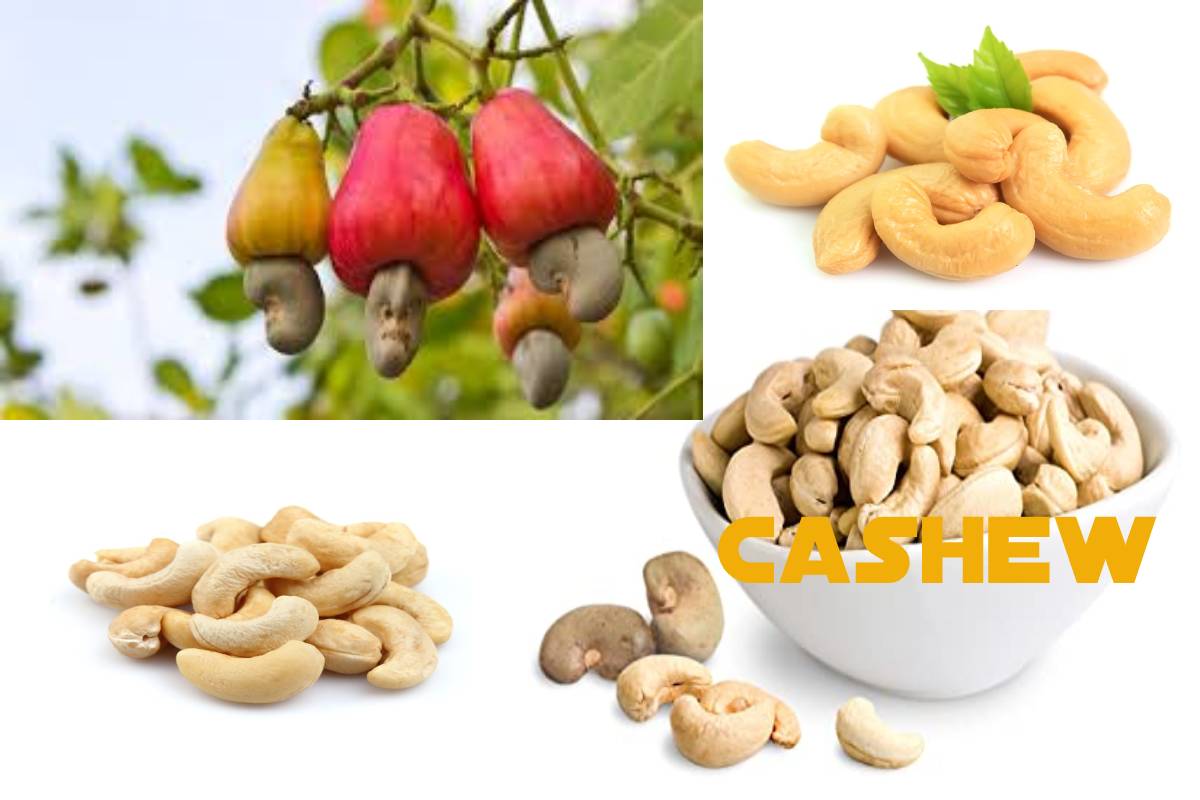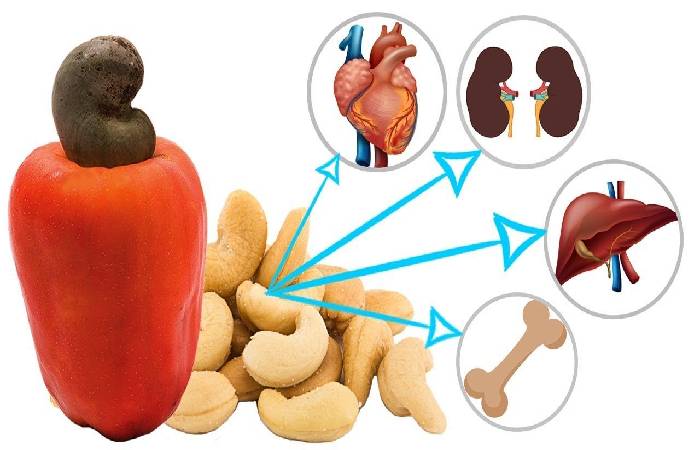Table of Contents
Cashew Definition
The Cashew ( Anacardium occidentale ) is a botanical curiosity because it produces dried fruit and fresh fruit.
The dried fruit with a hard shell and kidney shape, 3 to 5 cm in length, contains the seed, the edible Cashew, white or ivory, and weighs about 10 g.
The peculiar thing is that the peduncle that joins this dried fruit to the tree branch develops to form a large fleshy pseudo fruit, yellow, pink, or red and up to 11 cm in length, which can also eat.
The dried fruit, the name cashew, was given by the French monk and naturalist André Thevet, whose shape reminded him of an inverted heart (“ana” means “upwards” and “Cardium” means “heart”).
What are the Properties of Cashew?

The recommended serving of cashews is about 30 grams, which corresponds to about 18-20 seeds. This amount provides 172 calories, 14 g of fat, 4.6 g of protein, 10 g of carbohydrates, and 1 g of fiber.
Perfect Fat Ratio
- Many people avoid this because of their fat content, but they all have a healthy diet if consumed in adequate amounts.
- The Cashew stands out as one of the healthiest due to its nutritional profile.
- The total amount of fat is less than in almonds or walnuts.
- The proportions of saturated, monounsaturated, and polyunsaturated fatty acids are very close to the 1: 2: 1 ratio that nutritionists consider ideal.
- It means that it has twice or more monounsaturated fatty acids, such as olive oil.
- The proportion of healthy fat is higher than in peanuts, pine nuts, pistachios, walnuts, pumpkin seeds, or sunflower seeds.
Valuable Minerals: Copper, Magnesium, and More
- Copper and magnesium, two minerals that are scarce in many people’s diets, are found in abundance in Cashew.
- Copper participates in forming red blood cells, maintaining blood vessels’ structures, nerves, bones, hair, and skin, and producing energy from nutrients, especially in the immune system’s functioning.
- As for magnesium, an essential mineral for the nervous and musculoskeletal systems, a handful of cashews covers up to 26% of daily needs.
- In addition to copper and magnesium, the Cashew contains significant proportions of iron (9% of the daily needs in a 30 g serving), zinc (20%), phosphorus (20%), and selenium (10%).
- Iron is essential for transporting oxygen to all cells, while zinc and selenium collaborate with the defenses to eliminate viruses, pathogenic bacteria, free radicals, and precancerous cells.
Quality Proteins
- Each 100 g provides 15 g of protein, so a serving provides around 10 percent of daily needs.
- The most exciting thing is that the amino acids are ideal for their assimilation, as in animal origin or soy proteins.
- Thus they favor the perfect regeneration of tissues and the development of physiological processes.
- It also highlights the proportion of tryptophan, which in cashew nuts is higher than in any other food: in 30 g, there is 72 mg of tryptophan.
What are the Benefits of Cashew?
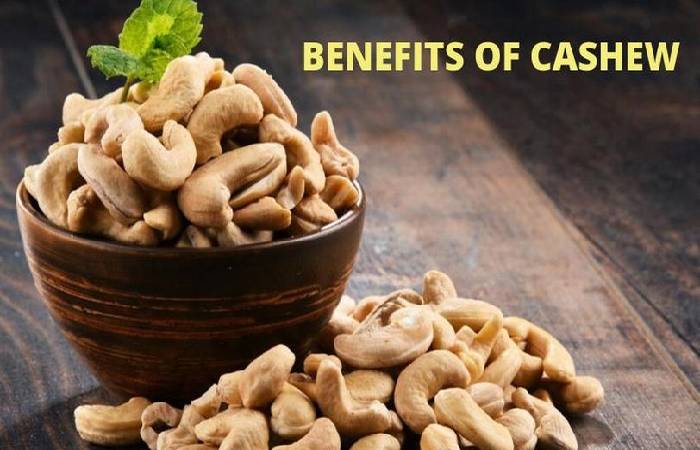
The extraordinary composition of the cashew nut translates into several benefits for well-being and health.
1. Lower Cholesterol and Triglycerides
- Cashew nuts’ fat profile is optimal for controlling cholesterol and triglycerides, which lowers heart disease risk.
- The effect of its fiber and antioxidants reduces it even more.
- Several studies indicate that consuming moderate servings – a handful – of nuts four times a week.
- As the quality of cashew fats is better than that of the nuts’ average, it can assume that the percentage may be higher in your case.
- Contributing to the definition of cashew nuts as a beneficial food for the cardiovascular system is its content of phytosterols, tocopherols, and squalene, all of them antioxidant plant compounds that reduce the risk of heart disease.
- Phytosterols, which are part of the natural composition of cashew nuts, are the same ones that are artificially added to certain foods to sell them as heart-healthy.
2. Fit Bones and Muscles
- Cashews are an abundant source of magnesium, a mineral that is part of the bones.
- Through a mechanism of balance with calcium, it contributes to relaxation and the excellent state of the nervous system and muscles.
- Magnesium is as necessary for bone strength as calcium.
3. Tranquilizer and Sleep Inducer
- Cashew is one of the primary food sources of tryptophan.
- This amino acid is a precursor to the synthesis of serotonin, a neurotransmitter associated with the feeling of well-being.
- Specifically, its balance about other neurotransmitters is necessary to regulate appetite and body temperature, intellectual functions, control anxiety.
- Tryptophan is considered a stimulant of sleep and the sensation of pleasure, so it is a good idea to go to bed well served.
- To the effect of tryptophan are added those of B vitamins. Even a moderate serving of 30 g provides 5% of the daily needs for vitamin B2 and 6% for vitamin B1 and B6.
- It, in combination with tryptophan, has a positive effect on depressed moods.
4. Is it an Aphrodisiac?
- In Brazil and Central America regions, Cashew has a reputation as an aphrodisiac, which says many foods, especially if they have striking shapes.
- But in their case, it could be justified by the abundance of zinc, a mineral necessary for the synthesis of male sex hormones.
How to use Cashew in the Kitchen?
After the pick, the cashews steam to neutralize the irritating compounds found in the shells. They can then market as is, or lightly fried to obtain a crisper, tastier, and more palatable result.
They also eat caramelized or coated in chocolate.
1. Essentials in Oriental Cuisine
- Cashews highly appreciate the countries where they originate from and increasingly use in vegan, international and avant-garde cuisine.
- Their delicate flavor, particularly their honeyed texture, makes them very different from other nuts, mostly cooked.
- They have a great affinity with spices like pepper or cardamom and other ingredients like coconut or ginger.
- It makes them very attractive to Asian cooks, especially from India, who use it frequently in numerous recipes.
2. With Cereals and Vegetables

- It can enrich basmati rice dishes, couscous, and especially bulgur, cracked, and pre-cooked wheat with a sweet taste.
- It greatly enhanced by adding a few roasted cashews.
- Sautéed with spinach and a little garlic, they are delicious and go well with all kinds of vegetables, including artichokes.
- Well chopped, they can also give consistency and texture to millet or seitan croquettes.
3. Winter Salads
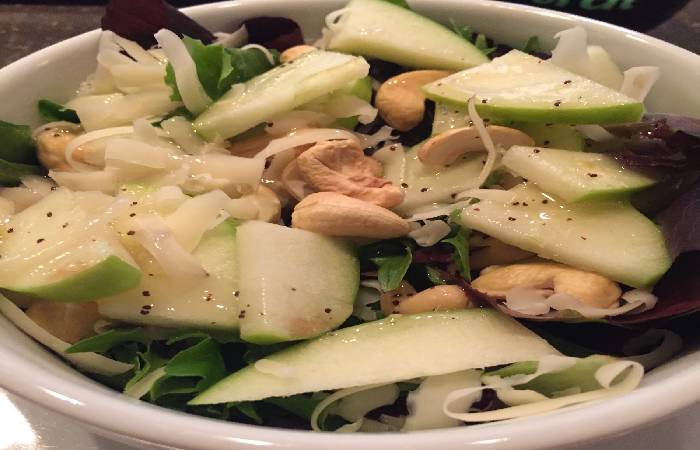
- Winter salads are ideal for including cashews, especially if they have an apple, endive, carrots, or pumpkin.
4. Cashew Butter
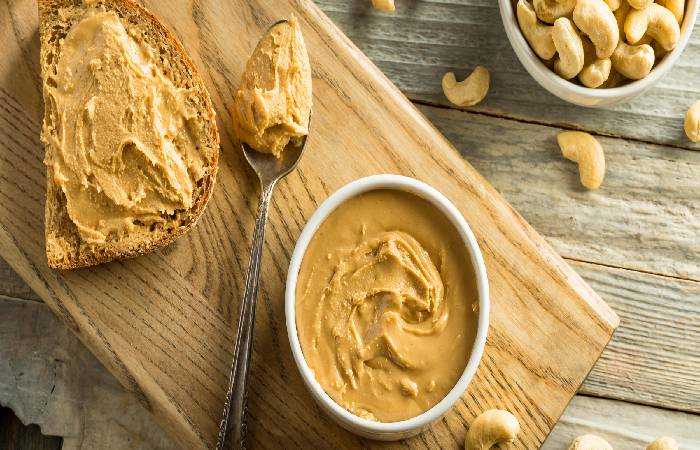
- A by-product of this nut is cashew butter. It resembles peanut, but it is somewhat sweeter and creamier. It is a good idea for spreading on toast or as a base for making sauces.
- Cashew can also use in sweet recipes and has the advantage that it is less caloric than milk butter.
- It is also the basis for making all kinds of vegan “cheeses.”
Also Read: Chest Press – Definition, Perform, Benefits, and More
- READ MORE:- heaalthnwelln

